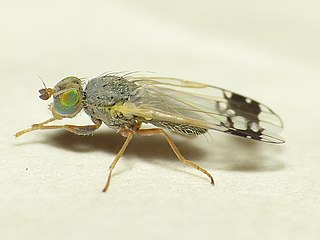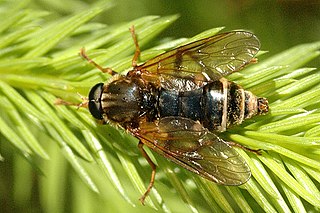
The soldier flies are a family of flies. The family contains over 2,700 species in over 380 extant genera worldwide. Larvae are found in a wide array of locations, mostly in wetlands, damp places in soil, sod, under bark, in animal excrement, and in decaying organic matter. Adults are found near larval habitats. They are diverse in size and shape, though they commonly are partly or wholly metallic green, or somewhat wasplike mimics, marked with black and yellow or green and sometimes metallic. They are often rather inactive flies which typically rest with their wings placed one above the other over the abdomen.

Actina chalybea is a species of 'soldier flies' belonging to the family Stratiomyidae subfamily Beridinae.

Chloromyia formosa is a species of soldier flies belonging to the family Stratiomyidae. Another name for it is Broad centurion.

Stratiomys is a genus of flies in the family Stratiomyidae.

Oplodontha is a genus of flies in the family Stratiomyidae.

Oplodontha viridula, the common green colonel, is a European species of soldier fly.

Sargus iridatus, the iridescent centurion, is a European species of soldier fly.

Pachygaster is a genus of flies in the family Stratiomyidae.

Oxycera pardalina, the hill soldier, is a European species of soldier fly.

Clitellaria is a genus of flies in the family Stratiomyidae.

Nemotelus is a genus of soldier flies in the family Stratiomyidae. Nemotelus is known from the Nearctic, Afrotropical and the Palaearctic regions.

Trupanea stellata is a species of tephritid or fruit flies in the genus Trupanea of the family Tephritidae.

Terellia tussilaginis, the gall fly, is a species of tephritid or fruit flies in the family Tephritidae.

Adoxomyia is a genus of soldier flies in the family Stratiomyidae.

Coenomyia ferruginea is a species of fly in the family Xylophagidae.

Dioctria hyalipennis is a Holarctic species of robber fly in the family Asilidae.

Dares verrucosus is a species of stick insects. Like most other members of the genus Dares, the species is native to Borneo, more precisely in the north of the island.
Flata is the type genus of planthoppers in the family Flatidae and tribe Flatini, erected by Johan Christian Fabricius in 1798. Species are recorded from subtropical and tropical Asia including India, China, Indochina and Malesia.

Haaniella gintingi is a stick insect species from Sumatra. It is a typical representative of the subfamily Heteropteryginae. The occasionally used common name Ginting’s Haaniella refers to the species name.
Chrysochlora is a genus of flies in the family Stratiomyidae.


















